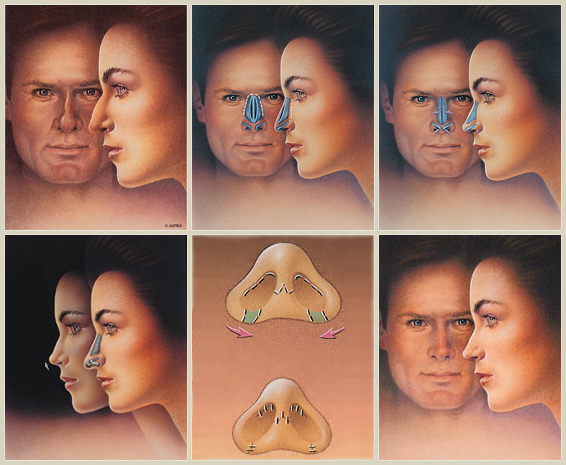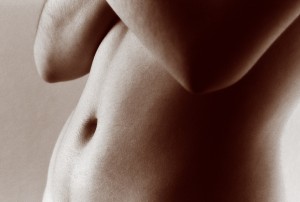Rhinoplasty is a procedure that can improve the appearance of your nose, as well as its structure and function. It is celebrated for its ability to bring balance to the face and enhance patients’ lives by increasing their confidence and self-esteem. Rhinoplasty from our plastic surgeon in Sacramento, Dr. Charles Perry, can enhance the look of your nose in a variety of ways; it can reduce or increase your nose’s size, change the shape of the tip, narrow the nostrils’ width, remove a bump, or change the angle or distance between the nose and the upper lip.
Breathing problems can be surgically addressed at the same time as cosmetic nose surgery is being performed.
- Rhinoplasty Candidates
- Septoplasty
- Ethnic Rhinoplasty
- Revision Rhinoplasty
- Dorsal Preservation Rhinoplasty
- Rhinoplasty Considerations
- Rhinoplasty Procedure
- Rhinoplasty Recovery
- Rhinoplasty Risks
- Rhinoplasty Cost
- Pre- and Post-Op Instructions
It is extremely common for rhinoplasty surgery to be performed at the same time as eyelid surgery, facelift surgery, or another facial plastic surgery procedure. If there is something you don’t like about your nose, you don’t have to live with it. Today’s rhinoplasty techniques are highly refined and can give you a look you love.

Am I a Candidate for Rhinoplasty?
The ideal candidate for rhinoplasty is healthy, mentally stable, and expects an improvement — not perfection — in the appearance of their nose. Rhinoplasty is not recommended for:
- Individuals with unrealistic expectations
- Individuals that have not completed their growth spurt – Surgeons generally wait to operate on girls until they are 14 or 15, and boys a little after that.
- Individuals suffering from certain medical conditions
- Individuals suffering from certain medical conditions Individuals with substance abuse problems that involve cocaine or other vasoconstrictive drugs – Use of these drugs puts patients at risk for major complications, including poor wound healing and nasal septal perforation.
**Disclaimer: If you are a smoker, you MUST DISCONTINUE smoking a minimum of 4 weeks BEFORE & AFTER SURGERY. A nicotine test will be administered.**
Our Patient Photos*
What Is Septoplasty?
The term septoplasty is often used interchangeably with rhinoplasty; however, these are distinct techniques. Septoplasty is a procedure designed to correct a deviated septum. This condition occurs when the bone and cartilage that separates the nostrils are displaced, an issue which can cause breathing problems. A deviated septum can also make the external nose appear uneven. While nearly everyone has some imbalance in the size or appearance of their breathing passages, individuals with a more pronounced difference may find this effect to be undesirable or uncomfortable. Septoplasty can be combined with rhinoplasty to address multiple concerns, or a septoplasty can be performed to simply correct the imbalance between passages. Depending on the extent of the displacement, septoplasty may or may not affect the appearance of the nose.
A deviated septum can develop naturally, as a result of genetic predisposition, or it can happen as a result of an injury or disease. A deviated septum that affects your ability to breathe normally is a medical condition. If this applies to you, your insurance may partially cover the cost of treatment. Regardless, Dr. Perry and our skilled team will correct the deviation of the septum in order to provide the best result possible. Remember to discuss this option during your initial consultation.
What Is Ethnic Rhinoplasty?
Dr. Perry recognizes that there is no single standard of beauty. Every person has unique cosmetic goals that are influenced by their age, race, ethnicity, cultural background, gender, and other factors. He customizes every procedure to suit the individual needs and aesthetic desires of the patient. With this philosophy in mind, Dr. Perry will discuss what you like and do not like about your nose and how you would like to improve its appearance. Ethnic characteristics are beautiful and typically can be preserved, accommodating your wishes. Taking into consideration these wonderful and inherent variations is important to achieving an aesthetically appealing and natural-looking result. Dr. Perry has extensive experience performing rhinoplasty on African-American, Asian, Middle-Eastern, and Caucasian patients, and he will develop a personalized treatment plan tailored to your individual anatomic indicators and standard of beauty.
What Is Revision Rhinoplasty?
Rhinoplasty requires a great deal of skill to perform well. If you underwent nose surgery with another plastic surgeon and are dissatisfied with the results, Dr. Perry can perform a revision procedure to modify the outcome and help you achieve the result you are looking for. Revision rhinoplasty is a more complex procedure that demands skill, experience, and an artistic eye. Dr. Perry will evaluate your cosmetic and functional needs, discuss your concerns, and develop a customized plan with your initial consultation.
Dorsal Preservation Rhinoplasty
Dorsal preservation rhinoplasty is a state-of-the-art nose surgery technique that enables Dr. Perry to adjust and modify the nasal appearance while preserving as much of its natural tissue structure as possible. For example, if the patient is having rhinoplasty to reduce the size/height of the nasal bridge, the dorsal preservation technique focuses on removing tissues such as bone and cartilage from underneath the surface of the bridge, rather than the top. This can help to preserve the natural dorsal lines while addressing the patient’s concerns and producing outcomes that look natural. Essentially, a dorsal preservation technique allows our plastic surgeon to make shape, size, and contour adjustments without having to sacrifice too much of the natural nasal anatomy. Additionally, this treatment can reduce the risk of potential nasal breathing problems following surgery, and it can lead to less residual swelling.
What Things Do I Need to Consider Before Undergoing Rhinoplasty?
Financial responsibilities
Fees associated with rhinoplasty surgery performed for purely cosmetic reasons are not covered by health insurance.
Further surgery may be necessary
In some cases, the patients are disappointed with their surgical results. They may choose to undergo additional surgery or learn to accept the result. Because the results of rhinoplasty surgery take a year to fully appear, patients must wait that long after surgery for additional procedures.
How Is Rhinoplasty Performed?
Rhinoplasty is a highly customizable surgery, and the technique used varies depending on the needs of the patient. There are two main approaches to completing rhinoplasty surgery: open rhinoplasty and closed rhinoplasty.
Open Rhinoplasty
In the majority of cases, Dr. Perry, uses the open rhinoplasty technique, in which the procedure is performed through a small incision made across the small strip of tissue between the nostrils. This approach is best suited for more extensive and complex rhinoplasty surgeries.
Closed Rhinoplasty
Less complicated nose surgeries can be performed using the closed rhinoplasty technique, which is performed from the inside of the nose through an incision made along the inside of the nostril.
While closed rhinoplasty offers a “scar-less” result, in that the scar will not be visible to others, the open rhinoplasty incision is so small and often heals so well that it becomes unnoticeable following full recovery. It’s also important to understand that to reshape the nose, cartilage grafts — using tissue harvested from the nose, ear, or another part of the body — are sometimes used.
What Is Rhinoplasty Recovery Like?
The healing process is an essential part of achieving the best possible outcome. The surgery is performed as an outpatient procedure, which means you should be able to return home the same day. We invite you to rest and relax, taking between one to two weeks off from work and your normal schedule. You must keep your head elevated at all times, including during sleep, and we can recommend some types of pillows and other tips to do this comfortably. Swelling and bruising are to be expected, and they should subside as you recover. Most patients only have significant bruising the first three to five days, and the swelling should also reduce rapidly. Some minor swelling can continue for up to a year, but this effect will likely not be noticeable to you after the first month. To minimize discomfort, we will prescribe prescription medication to manage any pain. And we will monitor your progress to ensure the best possible outcome.
What Are the Risks of Rhinoplasty?
While rhinoplasty is a popular procedure that generally yields good results, risks are inherent in any surgical procedure. The following list covers some, though not all, of the possible risks of rhinoplasty. You will have further discussion about the possible consequences of rhinoplasty with Dr. Perry during your consultation.
Bleeding
In rare cases, bleeding problems occur during or after surgery. To reduce the chances of bleeding problems, avoid aspirin and other anti-inflammatory medications for ten days before surgery. In extreme cases, hematoma (accumulation of blood under the skin) can cause scarring and delay healing.
Infection
Though unusual, infection can occur after rhinoplasty, and may require antibiotics or some other treatment. If cartilage grafts are used during surgery, infection may require their removal.
Scarring
It is possible for rhinoplasty surgery to result in abnormal scars in the skin and the nose’s deeper tissues. In addition, sutures can leave visible marks. Scarring can sometimes be treated with additional surgery.
Damage to deeper structures
Nerves, blood vessels, and cartilage can be damaged during rhinoplasty. This injury can be temporary or permanent, and its potential varies according to the type of rhinoplasty that is performed.
Numbness
Rhinoplasty carries a risk for permanent numbness of the nose. This loss of feeling can be partial or complete, and it is impossible to predict.
Asymmetry
As the human face is normally asymmetrical, perfect symmetry following rhinoplasty cannot be expected. In some cases, asymmetry will be marked. In some cases, asymmetry can be treated by laser therapy.
Nasal airway alterations
While your surgeon will take care to preserve and sometimes even improve the passage of air through your nose during rhinoplasty, it’s possible for changes to occur that may interfere with this normal passage of air, including nasal septal perforation.
Delayed healing or wound disruption
Some areas may heal slowly or abnormally following rhinoplasty, and areas of skin may die. This necessitates frequent changes of the wound dressings, or further surgery to remove dying tissue.
Long-term alterations in appearance
Factors unrelated to rhinoplasty, such as aging and sun exposure, can affect the appearance of your nose. In some cases, future surgery will be needed to maintain the results of rhinoplasty surgery.
Complications with cartilage grafts
If the goal of surgery is to alter the appearance of the nose’s tip, cartilage grafts may be needed, and these can introduce complications. Nasal septal perforations can occur, as well as complications of the donor site (the ear) including scarring, infection, and numbness.
How Much Does Rhinoplasty Cost?
The total cost of rhinoplasty at our practice usually ranges between $13,000 and $15,000. It is important to note that this range is general and that the price of rhinoplasty can vary from person to person since we customize each rhinoplasty treatment plan to suit the patient’s unique characteristics and desired outcome. The price of rhinoplasty surgery is based on factors such as the surgeon’s fee, anesthesiology and medical facility fees, the complexity and extent of the treatment, and other associated components. We want you to be comfortable, confident, and well-informed about your surgery prior to the event, and we will review the cost of your treatment plan with you in full during your initial consultation. If you have any questions or concerns at that meeting or after, we welcome those inquiries.
If you are having nose surgery for cosmetic reasons, medical insurance will not cover the cost. We offer a range of payment options, including plastic surgery financing available for qualified applicants through reputable third-party lending agencies. We can help you determine the right one for your lifestyle, budget, and needs at the initial consultation, as well.
Complete Pre- and Post-Operative Instructions for Rhinoplasty Patients
To make your rhinoplasty experience a positive one, we have prepared this comprehensive list of instructions. We recommend that you read them over as soon as your surgery day is scheduled. On your surgery day, print them out and bring them with you.
Rhinoplasty Instructions (printer-friendly)
*Individual Results May Vary







